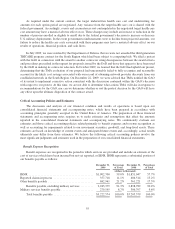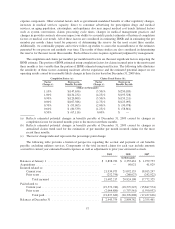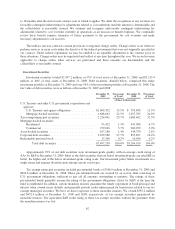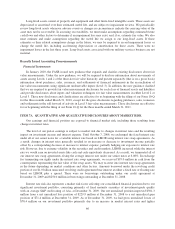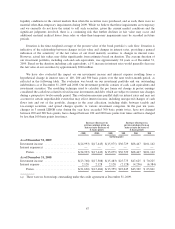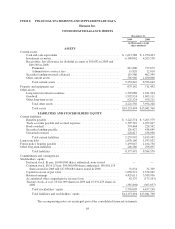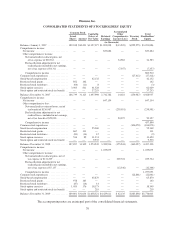Humana 2009 Annual Report Download - page 75
Download and view the complete annual report
Please find page 75 of the 2009 Humana annual report below. You can navigate through the pages in the report by either clicking on the pages listed below, or by using the keyword search tool below to find specific information within the annual report.We are required to test at least annually for impairment at a level of reporting referred to as the reporting
unit, and more frequently if adverse events or changes in circumstances indicate that the asset may be impaired.
A reporting unit either is our operating segments or one level below the operating segments, referred to as a
component, which comprise our reportable Commercial and Government segments. A component is considered a
reporting unit if the component constitutes a business for which discrete financial information is available that is
regularly reviewed by management. We are required to aggregate the components of an operating segment into
one reporting unit if they have similar economic characteristics. Goodwill is assigned to the reporting unit that is
expected to benefit from a specific acquisition.
Our strategy, long-range business plan, and annual planning process support our goodwill impairment tests.
These tests are performed, at a minimum, annually in the fourth quarter, and are based on an evaluation of future
discounted cash flows. We rely on this discounted cash flow analysis to determine fair value. However outcomes
from the discounted cash flow analysis are compared to other market approach valuation methodologies for
reasonableness. We use discount rates that correspond to a market-based weighted-average cost of capital and
terminal growth rates that correspond to long-term growth prospects, consistent with the long-term inflation rate.
Key assumptions in our cash flow projections, including changes in membership, premium yields, medical and
administrative cost trends, and certain government contract extensions, are consistent with those utilized in our
long-range business plan and annual planning process. If these assumptions differ from actual, including the
impact of the ultimate outcome of health care reform legislation, if any, the estimates underlying our goodwill
impairment tests could be adversely affected. Goodwill impairment tests completed in each of the last three years
did not result in an impairment loss. The fair value of our reporting units with significant goodwill exceeded
carrying amounts by a margin ranging from approximately 33% to 83%. A 100 basis point increase in the
discount rate would decrease this margin to a range of approximately 15% to 63%.
The ultimate loss of the TRICARE South Region contract would adversely affect $49.8 million of the
military services reporting unit’s goodwill. In July 2009, we were notified by the DoD that we were not awarded
the third generation TRICARE program contract for the South Region which had been subject to competing bids.
We filed a protest with the GAO in connection with the award to another contractor and in October 2009 we
learned that the GAO had upheld our protest, determining that the TMA evaluation of our proposal had
unreasonably failed to fully recognize and reasonably account for the likely cost savings associated with our
record of obtaining network provider discounts from our established network in the South Region. On
December 22, 2009, we were advised that TMA notified the GAO of its intent to implement corrective action
consistent with the discussion contained within the GAO’s decision with respect to our protest. At this time, we
are not able to determine what actions TMA will take in response to recommendations by the GAO, nor can we
determine whether or not the protest decision by the GAO will have any effect upon the ultimate disposition of
the contract award.
Our current TRICARE South Region contract covers benefits for healthcare services provided to
beneficiaries through March 31, 2010. On December 16, 2009, we were notified by TMA that it intends to
exercise its options to extend the TRICARE South Region contract for Option Period VII and Option Period
VIII. The exercise of these option periods would effectively extend the TRICARE South Region contract through
March 31, 2011. We will continue to assess the fair value of our military services reporting unit each reporting
period based on our estimate of future discounted cash flows associated with the reporting unit, primarily derived
from cash flows associated with the TRICARE South Region contract. We will recognize a goodwill impairment
if and when our impairment test indicates that the carrying value of goodwill exceeds the implied fair value. We
expect that as the ultimate March 31, 2011 contract end date nears, if our current contract is not extended further
and we are not awarded the new third generation TRICARE program contract for the South Region, future cash
flows will not be sufficient to warrant recoverability of all or a portion of the TRICARE goodwill. Given these
facts, we would expect a goodwill impairment during the second half of 2010. Refer to Note 16 to the
consolidated financial statements included in Item 8.—Financial Statements and Supplementary Data for further
discussion of the TRICARE South Region contract.
65


